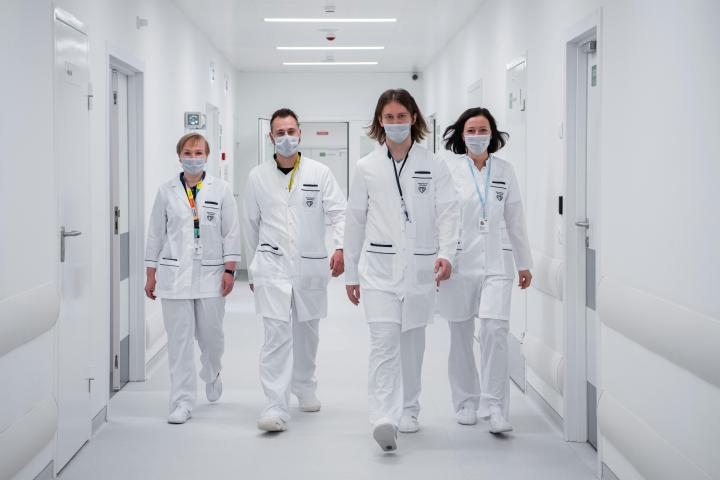
Healthcare Insights: Physicians and the Vaccine Crisis
By John August
Public concern over vaccine recommendations has been building ever since the new Administration took office on January 20, 2025. Concern has accelerated to chaos as the Health and Human Services Secretary Robert F. Kennedy, Jr, has fired the entire Advisory Committee on Immunization Practices (ACIP) as well as the head of the Centers for Disease Control (CDC). Shortly thereafter in mid-September, the new ACIP convened and issued guidelines for COVID and other vaccines that are causing health experts, state governments, and insurance companies to act to ensure that life-saving vaccines are available. The medical and scientific communities are deeply concerned that the inexperienced and anti-vaccination-dominated panel will cause delays and shortages of vaccines.
And in the state of Florida, the nation’s third most populous and fastest growing state in the nation, the state Surgeon General announced the elimination of mandatory immunizations.
These actions are causing fear and confusion among parents about childhood immunizations, and among people of all ages regarding COVID, flu, and other important vaccines.
Just take a historical look at the record of childhood immunizations and the prevention of illnesses that can cause harm and even death to children:
Diphtheria
Hepatitis A
Hepatitis B
Measles
Mumps
Pertussis
Polio
Rubella
Congenital rubella
Smallpox
Tetanus
In the face of such overwhelming data, it seems unimaginable that we as a nation are now experiencing public policy that is creating official barriers to safe and effective vaccines, while exacerbating growing hesitancy among members of the public to have their children vaccinated, as well as adults against diseases that impact people of all ages.
As I will point out in this article, there is a long history of vaccine skepticism and hesitancy among the public. However, there is no precedent for official public policy to encourage vaccine hesitancy or create barriers to their availability.
In the middle of this “vaccine chaos”, are the healthcare providers and practitioners who have their own professional and ethical standards to see to it that their patients receive life-saving vaccines.
Central to the ILR School’s mission is to study the “world of work”. This issue of Healthcare Insights explores the vaccine chaos from the point of view of physicians: how are they thinking and feeling about their patients and themselves during this crisis?
In recent issues of Healthcare Insights, I have spoken with physicians about the impact on their practice of immigration raids, cuts to Medicaid, and reductions in medical research such as research on maternal death rates. In all of these cases, physicians speak about how these barriers to care cause deep reflection and professional and personal crisis; how the health care system itself is standing in the way of their ability to treat patients as they were educated to do, as well as apply a lifetime of experience which they bring to each patient encounter and relationship.
Dr. Amber Higgins, an emergency room and family practice doctor in Delaware told me that: “We physicians keep all these things to ourselves and are not good at seeking care for ourselves when we need it. These burdens pile up, and we face burnout as a result.”
What I am learning is that burnout and moral injury among healthcare professionals has been building for many years. Systemic barriers stand between physicians and patients, challenging the practice of medicine as they have been trained to do. This has been a tragic dynamic for many years now.
What I am hearing more and more about of late is the need for individual and collective action to stand up to system barriers and public policy that are causing patients to suffer unnecessarily. More and more physicians are leaving the burnout concerns behind and declaring the need for action!
For this article I interviewed two experienced doctors: an internal medicine doctor and a pediatrician. They requested anonymity as they do not know if their institutions that they work for will stand behind them in these times of threats from government.
Here is what I learned from a 40-year internal medicine practitioner who like most attending physicians teaches and mentors interns, residents, and young doctors.
I began by asking him about the Hippocratic Oath, and what the impact is on himself as a clinician, to “do no harm” in this time of public policy crisis on vaccines. He told me that the Hippocratic Oath had little relevance to either legal or personal impact on the day-to-day. He shared that “there are three types of people when it comes to vaccines: people who want them, people who don’t want them, and those that are in the middle and aren’t sure."
He said that evidence has shown that persuasion on the facts has proven not to be terribly effective. Instead, doctors are trained to discuss with their patients’ medical conditions and how to solve them or prevent them. The education process with the patient works best when the issue at hand is discussed within the experience of the patient. He said that it is relatively straightforward to describe a condition and how it will inevitably get worse, step by step. There are medical practices that can be done to slow, reverse, or prevent these inevitabilities. The same approach applies to vaccine hesitancy. This method of discussion is most often successful.
The doctor said that his encounters with individual patients are not what worries him or saps his energy.
By contrast he said what really worries him is the growing need to do things that physicians are not trained to do: to protect the “public square”.
He shared his vision of the destruction of vaccine availability and how public confidence in vaccines represents the destruction of the Town Square, which for him leads to a challenge to his personal conscience to act in the political and governmental space, to be responsible for speaking out. He explained: “If I am walking past the town square, the center of civic life in my community, and I see someone throwing a rock through the window of one of the churches or other houses of worship, do I stand by and do nothing because the rock was not thrown at my house of worship? Or do I act because all of the churches are in the Town Square as representations of the community and the values that we all share? And if I don’t act, how have I in my own way contributed to the destruction of the Town Square?”
“Today, what is being done to vaccines by my government is like a rock thrown through the window of a building in the Town Square. Vaccines are so close and deep to what we have been trained in. As such, I must ask: are we shirking our responsibilities as physicians when we see that the Town Square is being vandalized and we do nothing?”
“Treating one patient at a time and taking them through the steps to accept vaccines is just hard work, work we are trained to do. Taking collective action now to protect vaccine availability and to encourage vaccine acceptance is required to protect us from the next pandemic. To step into a role in collective action is a new challenge, one that we are not trained for.”
Some historical perspective
Are vaccine hesitancy and anti-vaccination sentiments new?
The answer to that question is a resounding “NO”.
As noted in the article “Vaccine Hesitancy: Contemporary Issues and Historical Background”:
“Resistance to vaccination is not a recent occurrence. Since the first smallpox vaccine was developed by Edward Jenner in 1796, skepticism and suspicions about vaccines and the motivations behind their use have existed.”
Between 1920 and 1970, new vaccines for tuberculosis, yellow fever, whooping cough, tetanus, and polio were introduced, dramatically lowering childhood mortality. Polio, which either paralyzed and/or killed children, was a major public health focus in the 1950s. Significant declines in polio following the introduction of the Salk vaccine in 1954 bolstered public acceptance of vaccines in general. However, since the beginning of vaccines being marketed, public concerns about their efficacy and overall safety have existed.”
The article continues:
“The success of vaccination programs means that fewer lay individuals and health professionals have first-hand experience or knowledge of the risks of vaccine-preventable diseases (VPDs). Consequently, attention is now often focused on the risk or perceived risk of vaccines or vaccination, rather than on the risk of infectious diseases.
The lack of trust in vaccination has been reinforced by several high-profile examples, in particular the paper by Wakefield, which proposed a link between autism and the MMR vaccine. Although the paper was retracted and Wakefield’s findings proven to be flawed, it had long-term impacts on vaccine compliance.”
Omission bias, the tendency to regard the negative consequences of an action (commission) as being worse than the negative consequences of inaction (omission) even when the latter affects more individuals or occurs more often, is suggested to play a role in vaccine hesitancy. Some individuals believe it is more detrimental to vaccinate a child when the vaccination may cause harm than not to vaccinate, despite the fact that vaccination generally reduces the risk of harm. One possible explanation for this decision is that vaccines are administered as preventive measures to healthy individuals; thus, their benefits can only be estimated accurately at the population level, whereas their risks (real or alleged) can be seen at
the individual level.”
What will it take to restore confidence in vaccines?
There is broad consensus that accurate information about vaccines delivered by trusted leaders in communities is highly beneficial. It is just as widely understood that healthcare practitioners are trusted by patients and are in a strong opposition to promote vaccine acceptance and confidence.
There is also substantial literature which supports mandatory vaccination, particularly to mitigate infectious diseases. One of the most common arguments put forward by bio-ethicists focusses on preventing harm to others. In 1859, the philosopher John Stuart Mill argued that individuals should be free in making decisions if their actions are not harmful to others, also known as the harm principle. If their decisions harm others, then governmental coercion and the restriction of liberty are justifiable.Mandatory vaccination can be ethically justified if the following conditions are met: the threat to public health is grave, the confidence in safety and effectiveness is high, the predicted value/benefit exceeds the alternatives, and the coercion is applied in a proportional manner (e.g., non-compliance penalties or costs are reasonable).
There is a long history in our country of mandatory vaccination. Such rules are established by government, and while there are some penalties associated with non-compliance with mandatory vaccines, the ultimate test of success of mandatory programs are that most people have faith in the institutions that support the mandatory vaccine requirements. After all, if a substantial portion of the population disregarded the requirements, there is little that the government could do to achieve compliance.
In “A Look at Recent Changes to State Vaccine Requirements for School Children” the authors note that: “All states currently require children to be vaccinated against certain diseases in order to attend public schools. School vaccination requirements are an important tool for reducing the spread of diseases and increasing vaccination coverage rates. Required vaccinations across every state and D.C. include MMR, DTaP, polio, and varicella; some states also require hepatitis A, hepatitis B, meningococcal, and/or HPV vaccines. At this time, no states require the COVID-19 vaccine for school entry. While it has yet to be enacted, Florida’s plan to eliminate all school vaccination requirements would make them the first and only state to do so. However, as the divide between red and blue states on health policy grows, more states may consider moving this direction.”
The role of government in promoting mandatory vaccinations brings us back to the Town Square image described by my internal medicine doctor colleague, and the new role that physicians and others ought to play in the preservation of the Town Square.
Physicians are beginning to challenge the systemic barriers to their practice as evidenced by their demand that their medical societies and professional organizations provide leadership to break down all barriers that are negatively impacting the patient-physician relationship.
A meeting held earlier this year at the American Medical Association (AMA) as reported in the organization’s own newsletter illustrates this growing demand for collective action to protect the Town Square.
In this meeting, there was a heated discussion among attendees about a demand that the leadership of the AMA take a forceful and public stand against the proposed Medicaid cuts in the current administration’s “Big Beautiful Bill”.
AMA leadership defended its political approach as using a quiet “behind-the-scenes” approach to influence policy makers that it claimed has worked well over many decades. Attendees voices grew strong during the course of the meeting with a demand that while those methods have worked in the past, the severity of public policy impact on patients was so severe, the strongest collective action needed to be taken.
The evidence for the strong sentiment for collective action vs. quiet diplomacy was illustrated when the leadership of the meeting set up two microphones for discussion on the topic: one microphone marked “YES”, we support the current quiet, behind the scenes approach, and another microphone marked “NO”, or opposed to that quiet approach and in support of more collective public action to stop the Medicaid cuts.
When the meeting reconvened for the debate, the line to speak at the “NO” microphone ran out of the auditorium and into the hallways. By contrast there were zero speakers for the ‘YES’ microphone.
It appears that my internal medicine interviewee may be correct: that what is causing the most anxiety among physicians and other trusted voices on health and healthcare is that a new day of stepping into the politics of the “Town Square” is the growing and deep-seated sentiment that dominates healthcare worker response to the epidemic of vaccine chaos.
I also spoke with an experienced frontline pediatrician. He is deeply concerned that the prestigious institution that he works for will not stand up for him and his colleagues if they act on behalf of patients in the face of potential immigration raids, offers of gender-affirming care when the institution has banned such care base on pressure from the government, or if there are shortages of vaccines for children.
He, like his colleagues, must confront vaccine hesitancy among parents of the children he sees. He explained that there are understandable reasons why a parent is hesitant for example to have their tiny two-month-old vaccinated against Hepatitis B. He explained to me that it is of course highly unlikely that a two-month-old baby could contract Hepatitis B on their own. However, the medical concern is that an adult could contract the disease and pass it on to the child, and with no protection from the virus from the safe and effective vaccine, the young child could contract a variety of serious and completely preventable diseases of the liver.
He has this conversation with parents often, and sees it as part of his job. It is difficult and exhausting, but generally successful. However, when the President of the United States and the official public health infrastructure sows doubt about the need for the Hepatitis B vaccine for babies as has been done in the last few weeks, he is concerned that he will lose the ability to advise patients properly.
The Impact of immigration raids, Unprecedented Medicaid cuts, Funding elimination for medical and vaccine research and Complicity between the healthcare establishment and the government.
These current threats to public health promulgated openly and forcefully by the government adds to the already compromised ability to practice medicine due to systems barriers such as insurance intervention into doctors’ practices, along with bureaucratic decision-making about time spent with patients or other direct intervention by health systems in patient care against the advice of physicians.
The symbol of the Town Square under attack seems to be the most relevant metaphor of this moment for many physicians. How to stand up to this attack is the new frontier of learning and leadership among the nation’s doctors and other health professionals.
John August is the Scheinman Institute’s Director of Healthcare and Partner Programs. His expertise in healthcare and labor relations spans 40 years. John previously served as the Executive Director of the Coalition of Kaiser Permanente Unions from April 2006 until July 2013. With revenues of 88 billion dollars and over 300,000 employees, Kaiser is one of the largest healthcare plans in the US. While serving as Executive Director of the Coalition, John was the co-chair of the Labor-Management Partnership at Kaiser Permanente, the largest, most complex, and most successful labor-management partnership in U.S. history. He also led the Coalition as chief negotiator in three successful rounds of National Bargaining in 2008, 2010, and 2012 on behalf of 100,000 members of the Coalition.



